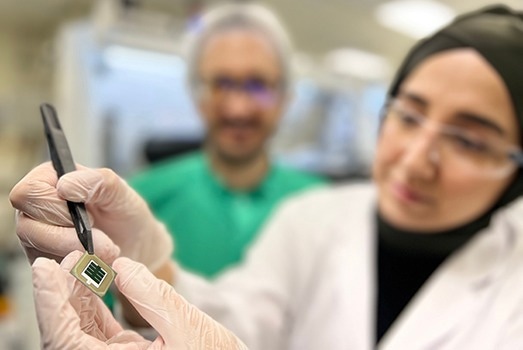The King Abdullah University of Science and Technology (KAUST) Photovoltaics Laboratory (KPV-Lab) has created a perovskite/silicon tandem solar cell with a power conversion efficiency (PCE) of 33.2 %, breaking the previous record held by Helmholtz Zentrum Berlin (HZB) at 32.5 % PCE. This is the highest tandem device efficiency ever.

KAUST postdoctoral fellow Dr. Esma Ugur displays the perovskite/silicon tandem solar cell that she and team researchers in the KAUST Photovoltaics Laboratory developed, recognized as the world’s most efficient silicon/perovskite tandem solar cell at 33.2 % PCE. Image Credit: King Abdullah University of Science and Technology
Crystalline silicon solar cells, which currently dominate the global photovoltaic market, have a module efficiency of about 20-22 %. However, to support global renewable energy targets, the solar energy industry needs advanced components and methods that can achieve even higher efficiencies.
KAUST is at the forefront of research on tandem solar cells, which combine silicon and perovskite sub-cells, as a potential, highly effective, and practical substitute for traditional crystalline solar cells.
KAUST's tandem device was ranked first on the National Renewable Energy Laboratory’s (NREL) Best Research-cell Efficiency Chart and was certified by the European Solar Test Installation (ESTI).
Since 2016, the team has been steadily perfecting the perovskite/silicon tandem cell concept under the direction of Dr. Stefaan De Wolf, professor of material science and engineering and interim associate director of the KAUST Solar Center.
They did this by creating new materials, methods, and device structures and overcoming fundamental challenges, such as evenly covering the micrometer-sized pyramidal surface of silicon cells with perovskite material.
The resultant tandem solar cell combines two-sided, textured silicon bottom cells that are industrially compatible with perovskite top cells. The perovskite top layer absorbs blue light best, while the silicon foundation absorbs red light best.
The combination of these materials maximizes the absorption and conversion of solar energy into electricity more effectively than the conventional single-junction silicon analogs.
The innovation marks a significant advancement in the field of solar energy, especially at a time when industry forecasts predict that tandem perovskite/silicon technologies will capture over $10 billion of the global photovoltaic market share by 2032.
This new record is the highest PCE of any two-junction solar cell under non-concentrated light, attesting the tremendous promise of perovskite/silicon tandems to deliver ultra-high performance photovoltaic modules, which is critical to rapidly achieve renewable energy goals towards combatting climate change.
Dr. Stefaan De Wolf, Professor, Material Science and Engineering, King Abdullah University of Science and Technology
The most recent accomplishment was made possible by the combined knowledge and abilities of several lead researchers, particularly Dr. Esma Ugur, a specialist in optical spectroscopy and the analysis and visualization of cell defects, Dr. Erkan Aydin, an expert in the scalability and stability of ultra-efficient tandem solar cells, and Dr. Thomas Allen, a specialist in the development of c-Si bottom cells.
The team is investigating ways to scale up the production of perovskite/silicon tandem cells for commercial use with an area of more than 240 cm2, as well as techniques to create tandem devices that are incredibly stable and can pass stringent industrial stability procedures.